Biography
Irving Goff's parents, of Jewish origin, emigrated from Odessa, Ukraine to New York City in 1900. He grew up in the streets of Brooklyn and Long Island. He was a premier body builder (famous as the "Adonis" of Coney Island's Muscle Beach) and worked as an adagio dancer and professional acrobat before becoming an organiser for the Communist party in New York. [4]
Goff arrived in Spain on 4 April 1937, [5] where he joined the International Brigades, working as a driver. In December 1937, he volunteered for dangerous guerrilla operations which frequently required him to work behind enemy lines for up to weeks at a time. Working with fellow International Brigaders Alex Kunslich and William Aalto, Goff was trained by Soviet instructors in the use of pressure-sensitive explosives to destroy railroad tracks, bridges and power lines. Goff would later recall these periods behind enemy lines:
I froze up; my mind went blank. A second or two at most, but it felt like two hours ... Your mind tells you ... you're in a dangerous position; you're encircled by the enemy, and that was an overwhelming impact on your nervous system. [6]
One of their objectives was the destruction of the main supply bridge spanning the Albarracín River. The operation may have been the inspiration for Ernest Hemingway's novel For Whom the Bell Tolls . [7] When the book was published in 1940, Goff was critical of the novelist's ignorance of guerrilla operations and the way in which war was treated from "a romantic adventuristic point of view rather than [as] the grim, practical war that it was". [8] In a later interview he said:
I never saw Ingrid Bergman in all the time I was in the war. If I did, I might still be there [Laughs.] The way Gary Cooper blew that bridge - like blowing a seam in a coal mine. I've blown bridges. You put a detonator in the thing and then you'd better be twenty miles away. You went after bridges and railroads. Usually it'd last five or six days behind the lines. [9]
At the end of 1937, Goff took part in the Battle of Teruel, working behind enemy lines again with Kunslich, Aalto and Spanish guerrillas. On 23 May 1938, Goff, took part in the successful amphibious operation at Carchuna, Motril on the southern coast of Spain, which resulted in the rescue of 300 Republican prisoners held in the Fort of Carchuna. This raid constitutes the only operation of its kind ever undertaken by the Spanish army. [10]
In September 1938, with a Republican defeat in sight, the Abraham Lincoln Battalion was withdrawn from the front line and shortly afterwards disbanded. Irving Goff returned to the United States.
Once home, he resumed his activities in the Communist Party, and in 1940 was sent on a mission to investigate pro-fascist "synarchista" organizations in Texas, California and Mexico. Posing as a newspaper reporter, Goff filed regular reports about these groups with party leaders, but failed in his effort to link them with the right-wing group America First. [11]
Goff continued to campaign for the Spanish cause, and in February 1941, he led 28 Lincoln veterans in a Peace Motorcade to Capitol Hill to lobby against Francoist Spain receiving Lend-Lease aid. [12]
In 1941, Goff was approached by former Abraham Lincoln Battalion commander Milton Wolff to work for British intelligence through the Office of Strategic Services (OSS). On Goff's advice, Wolff invited other Lincoln veterans to participate in the group, including William Aalto, Milton Felsen, Mike Jiminez, Vince Lossowski and Alfred Tanz. After the attack on Pearl Harbor, the OSS leader General William Donovan turned the project into a wholly American operation. In 1942, Goff was transferred to North Africa, where he was put in charge of training Spanish recruits to operate behind German lines. Here, he was promoted by Donovan to second lieutenant. [13]
After the Allied invasion of Italy in 1943, the OSS Lincolns moved to Naples, where Goff's previous experience in Spain proved a boon for American intelligence. He was appointed by the OSS as liaison officer to the Italian Communist Party, and the Americans promptly started training programmes, using Italian volunteers to wage guerrilla warfare behind the German lines in northern Italy. Goff's infiltration programs parachuted thirty teams of radio operators and meteorologists into enemy-held areas to provide daily weather reports for the Allied air forces. Working with the Italian Communists, Goff built the most effective intelligence operation in northern Italy. With multiple teams behind German lines, he could count on fourteen separate radio reports every day. "We had guerrillas operating on every highway, every railroad, every German convoy. We had identifications, the material in every car on every highway reported through the network of radios". [14] Irving Goff was awarded for his service the Legion of Merit. [15] (R.A.Rosenstone, Crusade of the Left. The Lincoln Battalion in the Spanish Civil War, NY:Pegasus, 1969), p. 350.
After the war, Goff became the Communist Party's district organiser in New Orleans. During Henry A. Wallace's 1948 presidential campaign Goff encouraged black voter registration, agitated on behalf of black prisoners and jeopardized his life on several occasions by ignoring southern racial customs. [16] Studs Terkel later interviewed Goff about his wartime experiences as part of his Pulitzer Prize-winning oral history book The Good War .
Irving Goff died on 17 May 1989 in Los Angeles, California after a longtime heart condition. He was buried in Arlington National Cemetery.

The Office of Strategic Services (OSS) was the intelligence agency of the United States during World War II. The OSS was formed as an agency of the Joint Chiefs of Staff (JCS) to coordinate espionage activities behind enemy lines for all branches of the United States Armed Forces. Other OSS functions included the use of propaganda, subversion, and post-war planning.

For Whom the Bell Tolls is a novel by Ernest Hemingway published in 1940. It tells the story of Robert Jordan, a young American volunteer attached to a Republican guerrilla unit during the Spanish Civil War. As a dynamiter, he is assigned to blow up a bridge during an attack on the city of Segovia.

The Lincoln Battalion was the 17th battalion of the XV International Brigade, a mixed brigade of the International Brigades also known as the Abraham Lincoln Brigade. It was organized by the Communist International and named after President Abraham Lincoln who led the US during the American Civil War.
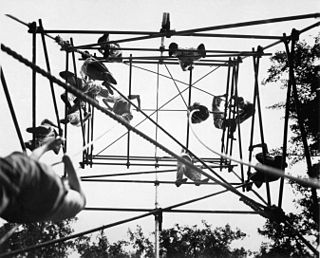
Operation Jedburgh was a clandestine operation during World War II in which three-man teams of operatives of the British Special Operations Executive (SOE), the U.S. Office of Strategic Services (OSS), the Free French Bureau central de renseignements et d'action and the Dutch and Belgian armies in exile were dropped by parachute into occupied France, the Netherlands and Belgium. The objective of the Jedburgh teams was to assist allied forces who invaded France on 6 June 1944 with sabotage and guerrilla warfare, and leading local resistance forces in actions against the Germans.

Ronda is a municipality of Spain belonging to the province of Málaga, within the autonomous community of Andalusia.
Michael McLaughlin, also known as Michael Walsh, is a British neo-Nazi. Born in Liverpool, McLaughlin was the son of an Irish republican and socialist, who was a veteran of the International Brigades.
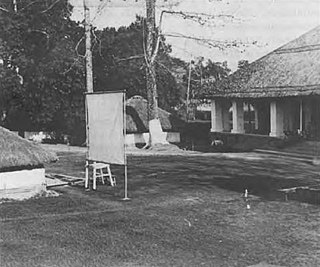
Detachment 101 of the Office of Strategic Services operated in the China-Burma-India Theater of World War II. On 17 January 1956, it was awarded a Presidential Distinguished Unit Citation by President Dwight Eisenhower, who wrote: "The courage and fighting spirit displayed by its officers and men in offensive action against overwhelming enemy strength reflect the highest tradition of the armed forces of the United States."

For Whom the Bell Tolls is a 1943 American epic war film produced and directed by Sam Wood and starring Gary Cooper, Ingrid Bergman, Akim Tamiroff, Katina Paxinou and Joseph Calleia. The screenwriter Dudley Nichols based his script on the 1940 novel For Whom the Bell Tolls by American novelist Ernest Hemingway. The film is about an American International Brigades volunteer, Robert Jordan (Cooper), who is fighting in the Spanish Civil War against the fascists. During his desperate mission to blow up a strategically important bridge to protect Republican forces, Jordan falls in love with a young woman guerrilla fighter (Bergman).

The Battle of Ilerda took place in June 49 BC between the forces of Julius Caesar and the Spanish army of Pompey Magnus, led by his legates Lucius Afranius and Marcus Petreius. Unlike many of the other battles of the civil war, this was more a campaign of manoeuvre than actual fighting. It allowed Caesar to eliminate the threat of Pompey's forces in Hispania and face Pompey himself in Greece at the Battle of Pharsalus.

Mikhail Efimovich Koltsov, born Moisey Haimovich Fridlyand, was a Soviet journalist, revolutionary and NKVD agent. He served as the editor-in-chief of the satirical magazine, Krokodil.

William Eric Aalto was an American soldier and member of Abraham Lincoln Battalion, a unit that volunteered to fight during the Spanish Civil War for the Popular Front.

Milton Wolff was an American veteran of the Spanish Civil War, the last commander of the Lincoln Battalion of XV International Brigade, and a prominent communist.

John Hadley Nicanor Hemingway was a Canadian-American fly fisherman, conservationist, and writer. He was the son of American novelist and Nobel Prize-laureate Ernest Hemingway.
The main strategy and tactics of guerrilla warfare tend to involve the use of a small attacking, mobile force against a large, unwieldy force. The guerrilla force is largely or entirely organized in small units that are dependent on the support of the local population. Tactically, the guerrilla army makes the repetitive attacks far from the opponent's center of gravity with a view to keeping its own casualties to a minimum and imposing a constant debilitating strain on the enemy. This may provoke the enemy into a brutal, excessively destructive response which will both anger their own supporters and increase support for the guerrillas, ultimately compelling the enemy to withdraw. One of the most famous examples of this was during the Irish War of Independence. Michael Collins, a leader of the Irish Republican Army, often used this tactic to take out squads of British soldiers, mainly in Munster, especially Cork.
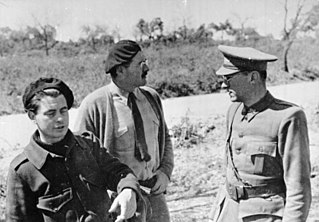
The North American Newspaper Alliance (NANA) was a large newspaper syndicate in operation between 1922 and 1980. NANA employed writers such as Grantland Rice, Joseph Alsop, Michael Stern, Lothrop Stoddard, Dorothy Thompson, George Schuyler, Pauline Frederick, Sheilah Graham Westbrook, Edna Ferber, F. Scott Fitzgerald, and Ernest Hemingway.
The head of the Office of Strategic Services (OSS), William Donovan, created the X-2 Counter Espionage Branch in 1943 to provide liaison with and assist the British in its exploitation of the Ultra program's intelligence during World War II. A few months before, Donovan had established a Counterintelligence Division within the Secret Intelligence Branch of the OSS but rescinded this order upon development of the X-2. The X-2 was led by James Murphy, whose branch would have the power to veto operations of the Special Operations and Secret Intelligence Branches without explanation. Donovan modeled the Counter Espionage Branch on British Counter Espionage. With the creation of the X-2 Branch, the British insisted that it follow British security procedures to maintain the secrecy of Ultra. The X-2 established separate lines of communication for itself as a self-contained unit. By the end of World War II, the X-2 had discovered around 3,000 Axis agents.
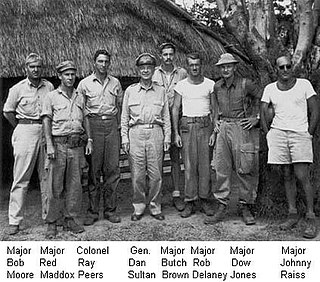
Behind the Burma Road is a 1963 book by William R. Peers and Dean Brelis that describes the American guerrilla warfare operations, including those of OSS Detachment 101, during the Burma Campaign in the China Burma India Theater during World War II.

The American Medical Bureau (AMB), also known as the American Medical Bureau to Save Spanish Democracy, was a humanitarian aid institution associated to the Lincoln Battalion that provided a medical corps, nursing systems for casualties, accommodation, and treatment to those who were wounded while they fought for the Spanish Loyalists during the Spanish Civil War (1936–1939).

Undercover, also known as Undercover: How to Operate Behind Enemy Lines and How to Operate Behind Enemy Lines, is a 1943 Office of Strategic Services training film, directed by and featuring John Ford. It was edited by Ford's longtime collaborator Robert Parrish.
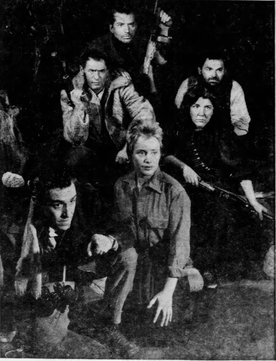
"For Whom the Bell Tolls" was an American television play broadcast in two parts on March 12 and March 19, 1959, as part of the CBS television series, Playhouse 90. It is a television adaptation of the 1940 novel by Ernest Hemingway. John Frankenheimer was the director. The cast included Jason Robards, Maria Schell, and Maureen Stapleton.

















